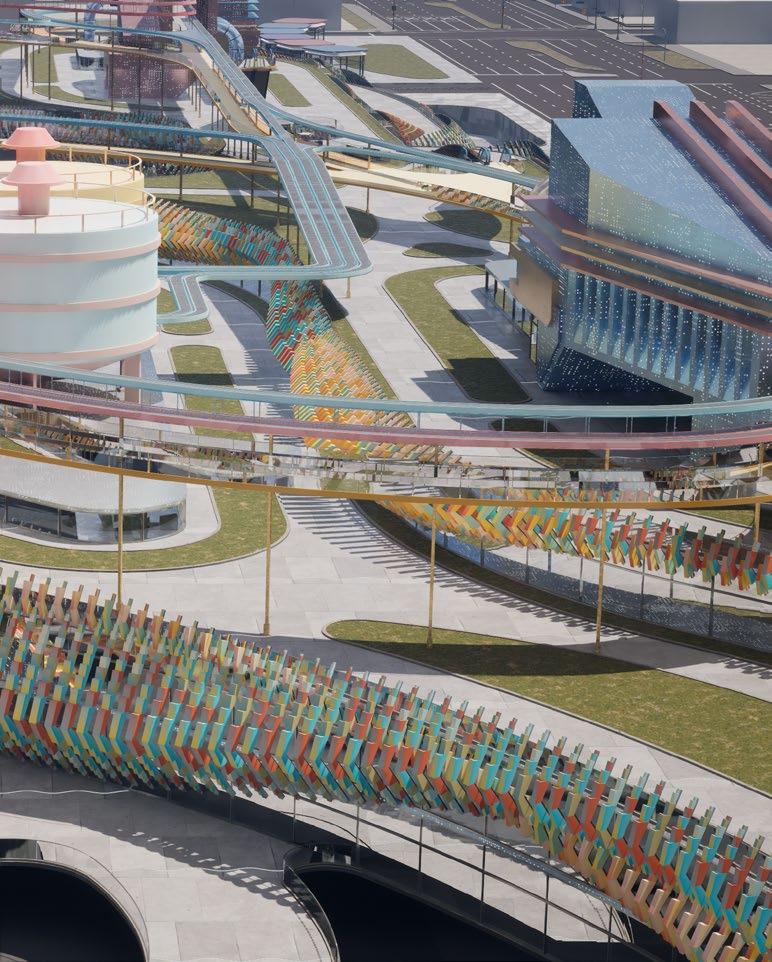Shopping Universe
New Experiences at the Edge of Nature and Urbanity



Shopping mall is facing enormous challenges that leads the industry to death.
The spatial strategies, the overwhelming advertisement, and the fast fashion promote mental acquisition by familiarizing customers with merchandise’s actual and fantasized quality, which invokes unnecessary consumption—a phenomenon against growing sustainability concerns.
Shopping mall has been populated globally yet has limited variation regardless of the local cultural and social characteristics, which makes it losing attraction because of repeated patterns and monotonous functions.
The malls had started to steeply decline in visitors due to the convenient and decentralized electronic commerce.
Although the functions and design of shopping spaces are still being determined, the shopping center is still necessary but needs to be reinvented for citizens as it serves as a third place—an easily accessible location where people could gather, socialize, and unwind in public, playing a vital role in fostering community, promoting inclusivity, and strengthening civil society.
To reshape the future landscape of retail, shopping malls in this digital age should look for a reconfiguration that introduces new programs to convert itself into third place—a much more public and open space, providing an immersive and interactive experience that intertwines with an urban ecosystem to attract target users who would otherwise not come.
To prepare for the future of retail, we must take into account the values of younger generations such as Millennials, Gen Z, and even Gen Alpha who concerned about environmental conservation, freedom of self-expression, and support sustainable consumption as they will be the ones shaping the future.
The younger generations care about sustainability, and this environmental awareness often translates into a greater love of nature.
The strategy is creating a new shopping biosphere instead of a transaction place, constructing distinctive identity for the shopping malls, establishing relationships between space and urban activities and experiences, associating shopping malls with sustainability and nature.
The close relationship between consumption and workspace is highlighted through the employment of paid workers. While work for one person, the employee, is consumption for another, the employer, it reveals that these two activities are not easily distinguishable. Consumption, often seen as a leisure activity and the opposite of work, is actually intertwined with work. This understanding challenges the casual dualism between public/private, work/ buying, and production/consumption.
The architectural space of a shopping mall brings together two essential elements: the labor space and the commercial space. These distinct areas are intricately intertwined, creating a dynamic and symbiotic environment. Exploring the links between work and consumption in the shopping mall reveals the relationships between the shopping mall, the wider economy, and the natural world. It disrupts the conventional notions of work and consumption, presenting them as interconnected rather than separate.
However, shopping malls face significant challenges, as their current model promotes unnecessary consumption and lacks variation, leading to declining visitor numbers. Despite this, shopping malls serve as vital "third places" where people gather, socialize, and unwind in public. They play a crucial role in fostering community, promoting inclusivity, and strengthening civil society. When considering the mall's role in recycling the heaps of waste it generates, it becomes essential to examine the spectacle of consumerism. It now generates use-value as infrastructure, continually evolving and mutating with the city.
A reimagined shopping mall presents an opportunity to transform it into more than just a transactional space. It reframes the way people consume and changes the relationship between production and consumption. By adopting a hybrid approach to space-making, the shopping mall architecture moves away from being solely a commercial space and becomes a factory-commercial hybrid space within a new commons.
This reimagined approach brings transparency to the lifecycle of products, promotes environmentally responsible building practices, and establishes a circular production and re-production chain. Consumers are actively engaged in repurposing specific objects, giving them a second life and redefining the role of "buying" and "discarding" in our society. Architecturally, the reimagined shopping mall embodies a system of spatial and labor-product relationships, extending beyond the physical limits of the building. It conveys the entire reality of production, from material extraction to product assembly and customization, organizing logistics for efficient management of workers and machinery.
These two interconnected spaces, the labor space, and the commercial space, provide visitors with a unique and transformative experience. The labor space offers transparency and authenticity, allowing consumers to witness craftsmanship and repurposing techniques firsthand. This fosters a deeper appreciation for sustainable practices. The commercial space serves as a bridge, connecting repurposed creations with consumers, facilitating economic transactions and providing educational opportunities.
By merging labor and commercial spaces, this architectural design cultivates a symbiotic relationship between production and consumption. It brings transparency to the lifecycle of products, engages consumers in the repurposing process, and creates a visually appealing and environmentally conscious shopping experience. Despite consumption often being seen as separate from work, these two activities are fundamentally intertwined in our lives, as we rely on consumer goods for daily necessities, creating work and driving capitalist forms of production and exchange. Machines would play a significant role in recycling the vast amount of waste generated by discarded products, bridging the gap between the product and its manufacturing processes. This would enable a circular production process and resourceful assemblage to function within the city. Additionally, the mall could engage consumers in the repurposing of consumption, reframing their roles in contemporary social and ecological environments. By associating itself with sustainability and nature, the shopping mall could create a distinctive identity.




The definition in the dictionary, the mall is mainly based on the model of fully enclosed large-scale commercial shopping complexes with associated passageways that appeared in the suburbs. The etymology of mall comes from a tree-lined walk called “The Mall” in St James’s Park in London in the 1730s. Therefore, this has become one of the essential qualities of the mall in modern society - a place for pedestrians. Buying and walking, the former defines the mall’s purpose, and the letter determines the form of the mall.
Southdale Center, built-in 1956, is Victor Gruen’s original concept for Minnesota’s shopping mall. Gruen weakened the exterior of Southdale Center to emphasize the mall’s interior. The comfortable, climate-controlled environment would encourage people to linger longer in the mall. It was designed to provide a diversified shopping experience, whereby the consumer
could choose to make purchhases leisurely through the mall.
Victor Gruen's design for Southdale become the single most influential new building type . Then mall proliferated, first in suburban America and then around the globe.
“Shopping centers have taken on the characteristics of urban organism serving a multitude of human needs and activities, thus justifying the designation: SHOPPING TOWNS.” 1 The mall, in his conception, stood in for the city center, and he placed the mall in direct connection with past forms where shopping was equal to the city. Therefore, from the scale of the small neighborhood to the metropolis, the mall would become urban itself. The figure above is Victor Gruen’s ideal cellular metropolis based on four overlaid public and private movements and spaces.

“By affording opportunities for social life and recreation in a protected pedestrian environment, by incorporating civic and educational facilities, shopping centers can fill an existing void. They can provide the needed place and opportunity for participation in modern community life that the ancient Greek Agora, the Medieval Market Place, and our own Town Squares provided in the past.”
-Shopping Town USA, Victor Gruen and Larry Smith, 1960

Through modernization, shopping malls are continually being reformulated and reshaped to keep up with the most subtle societal changes. Technology promotes the escalation of consumer culture. For example, air conditioning offers shoppers a comfortable environment to increase interior space depth for shopping. Meanwhile, people's love affair with malls continued for a while. Before we all lived and worked in comfortable, air-conditioned places, the mall was a fantastic place to escape from the heat and the heavy rain. It might have been the only air-conditioned place in town in the 1990s.
Victor Gruen designed his shopping mall to have blank facades, and boxy shapes with no signage on them, so that consumers would enter and be dazzled by the interior he created.
"Not only is shopping melting into everything in our life, but everything is melting into shopping." ⁴. However, nothing new is created; existing architectures are manipulated and regurgitated. Shopping spaces shape downtown areas, streets, airports, museums, playgrounds, and schools. The spaces have become like the
shopping mall, and shopping has found a way to expand by colonizing the public areas. It appeals to every public space because it offers an immediate means of survival. Eventually, shopping becomes the only principal mode people experience in a city, and even the city would be configured according to the mall.
The enclosed space for shopping, has been populated globally yet has limited variation regardless of the local cultural and social characteristics - similar atmosphere, same brands, and much alike circulation. The goals of those shopping mall designs are also identical- making a selling machine.
The encapsulated commercial machines in the enclosed and opaque buildings cut off the shopping mall from the outside physically and culturally. With the emergence of electronic commerce in recent years, the shopping mall has been losing their attraction because of repeated patterns and monotonous functions.

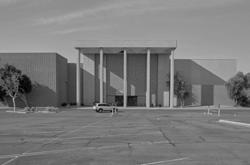









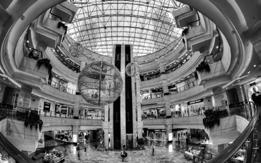

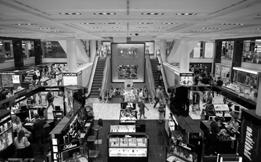









products is thrown away before it need to be
Though shoppers still make most purchases in stores, many brick-and-mortar stores have closed in recent years. Many analysts, such as Nick Egelanian, president of retail consulting firm SiteWorks, even predict that there will be approximately 150 malls left in the US in ten years.
People can buy everything by simply click "buy now" Shoppers prefer to make quick trips to shops in proximity or even online shopping. Indeed, some owners of shopping centers respond to the crisis by embracing new business strategies, such as The Grove in west Hollywood, which has a large center park highlighted by a water feature to attract customers. Nonetheless, the evolutional pace of shopping malls is way too slow, leading the industry to death. Even before the pandemic, the malls had started to steeply decline in visitors due to the convenient and decentralized electronic commerce.


The situations of shopping places nowadays raise a question: Do modern consumers need shopping centers? Or is E-commerce sufficient? Although the functions and design of shopping spaces are still being determined, the shopping center is still necessary but needs to be reinvented for citizens as it serves as a third place.
The concept of the Third place was originally introduced by Ray Oldenburg, an American sociologist, in response to the growing trend of suburban living, which led to the increasing privatization of home life. While homes represent the first place and workplaces are the second, the third place refers to the informal
gathering spots where authentic community and connections could be formed. These places included restaurants, markets, bars, gyms, libraries, and houses of worship. They were easily accessible locations where people could gather, socialize, and unwind in public, playing a vital role in fostering community, promoting inclusivity, and strengthening civil society. In other words, shopping mall plays a crucial role in everyday life in terms of communication, interaction, and entertainment.

With the abovementioned problems, a provocative concept that allows us to reshape the future landscape of retail and their role in the contemporary urban context is necessary. Shopping malls in this digital age should look for a reconfiguration that introduces new programs to convert itself into third place—a much more public and open space, providing an immersive and interactive experience that intertwines with an urban ecosystem to attract target users who would otherwise not come. It is also imperative to redefine the role of customers as citizens, which means selling as much as possible is not the priority for shopping malls but providing an experience connected to daily life and the city where it stands.
To prepare for the future of retail, we must take into account the values of younger generations such as Millennials, Gen Z, and even Gen Alpha. These groups are concerned about environmental conservation, freedom of self-expression, and support sustainable consumption as
they will be the ones shaping the future. As they gain more purchasing power and influence, it is important to understand their values.
For younger Millennials, buying products that reflect their values provides a means of expressing themselves without words. Many millennials support environmentally conscious political candidates and strive to be environmentally aware. This awareness often translates into a greater love of nature. This means that millennials are all about being close to nature and the object of their generation’s political affection. Gen Z, on the other hand, is interested in a company's values and mission and wants to connect with others who share their progressive ideas. They prioritize ethical, social, and sustainable consumption, and expect transparency and authenticity from retailers. This raises the question of how the relationship between younger generations, sustainability, and nature will shape the future of retail.


Thus, the strategy is creating a new shopping biosphere instead of a transaction place. In other words, to create distinctive identity for the shopping malls that should incorporate new programs, cultural interpretation, and social functions. To reattract visitors, the new shopping malls must construct relationships between space and urban activities and experiences. That is, a shopping mall can be associated with sustainability and nature.
1. Westfield's vision of the future of the mall: Destination 2028.
2.Interior of an abandoned shopping mall overgrown with plants,
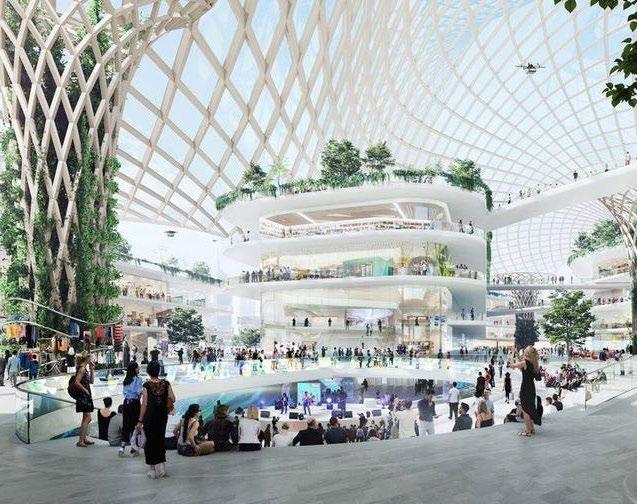




NochMall is the first department store for used goods in Berlin, and is much more than just a second-hand department store. They not only sell used furniture, clothing, electrical appliances, household goods, toys, books and thereby give them a second life, but NochMall is also a place to experience circular economy and waste prevention.

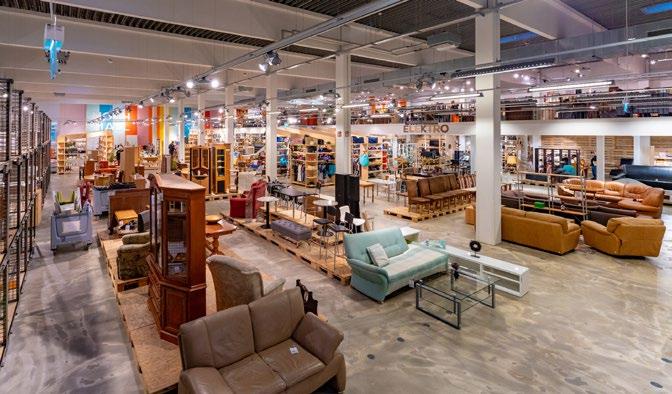

Goodwill is one of the region’s largest recyclers. They work with local agencies to recycle and re-purpose everything from electronics to books, and textiles to plastic toys, keeping tens of millions of pounds out of the landfills each year.




The Sunset Park Material Recovery Facility is a processing center for New York City’s curbside metal, glass, and plastic recyclables which is being undertaken by Sims Municipal Recycling and the City of New York. Located on an 11 acre waterfront pier in Sunset Park, the design was influenced by its programmatic use as a recycling center which inspired reuse throughout.
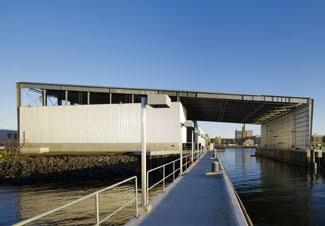

The masterplan organizes buildings to support functionality, creates distinct circulation systems to safely separate visitors from operations, and adds two acres of native plantings. Buildings are also organized to create the site’s own urban context.

The Education Center is one of the project’s most unique features. The structure contains programs for school children and the public including classrooms, exhibitions, and interactive demonstration displays. A key element of the design is a steel bridge which connects the Education Center to a viewing platform inside the Processing Facility. The viewing platform allows students and visitors to see the recycling process in action.

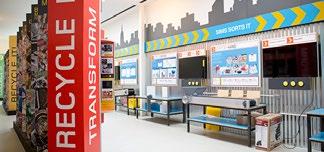
This word combines the concepts of retail, nature, and sustainability.
The word refers to the idea of incorporating natural elements and sustainable practices into the retail industry. It implies the use of environmentally friendly materials and methods in the design, production, and distribution of retail products, as well as the integration of natural elements, such as greenery or wood, into retail spaces.
In essence, "Naturetaility" encourages the use of sustainable practices in the retail industry to minimize environmental harm and promote a
closer connection between people and nature. It emphasizes the importance of balancing economic growth and consumerism with the need to protect the environment and preserve natural resources.
Foster + Partners / 2014

Elkus Manfredi Architects / 2002


1. No anchors.
2. Balancing private vs. public.
1. Using third place and nature to connect retail spaces and anchors.

2. Pedestrian street: blending into surrounding environment.

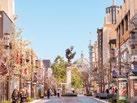
3. Lifestyle centers: alternative social gathering spaces



1. Radial layout: ence and diameter)
2. Tropical Forest attraction
3. Third places also attract
connect surrounding social gathering



Bayaty Architects / 2020
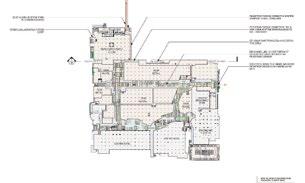
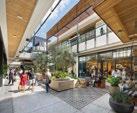





OJB / 2017
1. Radial layout: Flexible circulation (circumference and diameter)
2. Tropical Forest at the center becomes an attraction
3. Third places on the boundary of the nature also attract visitor to gather together
1. Grid layout makes a clear circulation.
2. Not having an alternative program to create more activities.
3. Lack of nature




Apollodorus of Damascus / 112 K11
KPF + RLP / 2019
Original Layout
Grid Small Retail
Variation C
Circulations


Phase A
Original Layout




Outer layer:
Middle layer:
Inner layer:
Center: Nature
Retail / Nature / Third Place
Original Layout
Grid Small Retail Spaces
Variation A
Reversed Nature
Variation B
Reversed Nature + Third Places Diffusion
Variation C
Circulations with Nature
Variation D
Nature Diffusion
Variation E
Split Small Retail Spaces with Third Place and Nature
Phase A
Original Layout
Outer layer: Anchor
Middle layer: Small retail
Inner layer: Third place
Center: Nature
Phase B
Third Places Diffusion
Third places diffuse into anchors and small retail spaces.
Phase C
Nature Diffusion
Nature diffuse from center, connecting all the retail spaces with third places.
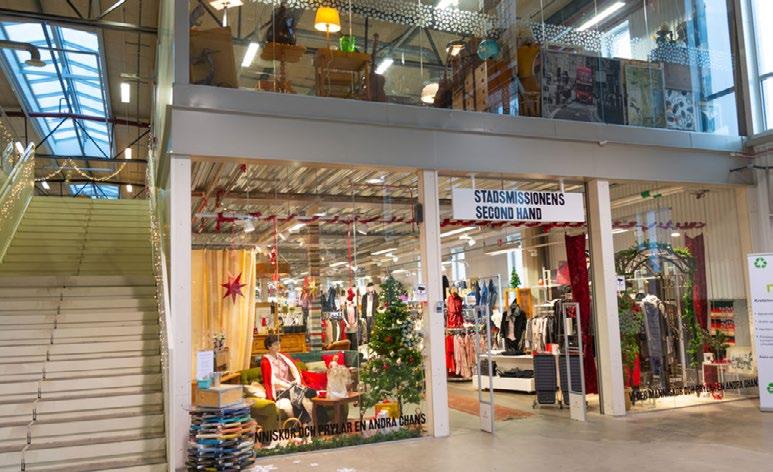
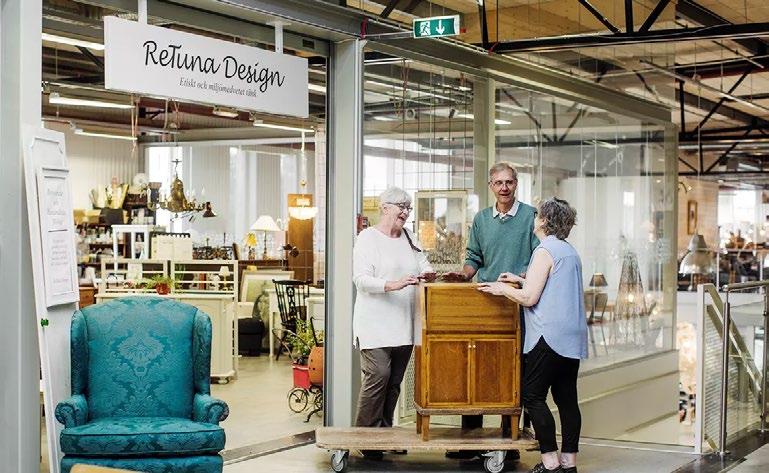

Consumers would be able to go through the process of repurposing a specific object which gets a second life, knowing a different way to the role of “buy” and “discard” in our city.
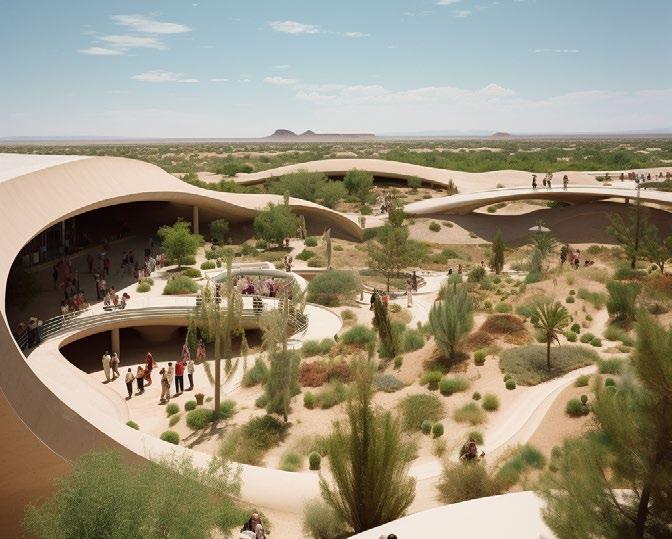


Hawthorne Plaza Shopping Center, once a bustling retail destination in Hawthorne, California, now stands abandoned, with only memories and stories remaining.
In February 1977, Hawthorne Plaza opened its doors to the public, offering a shopping experience with 134 stores and three anchor tenants: Montgomery Ward, The Broadway, and JCPenney.
The mall catered to the middle-class residents of the area and featured more affordable stores than nearby malls like South Bay Galleria, Manhattan Village, and Del Amo Fashion Center.
Despite its initial popularity, the mall faced challenges from the very beginning. In 1979, two shootings marred its early years.
The decline continued in the 1980s and 1990s due to the economic downturn in the area after cutbacks in aerospace jobs, white flight, and competition from other shopping centers. As a result, the mall’s number of occupied stores dropped from 130 in the late 1980s to 87 in 1994 and around 70 in 1998.
In 1999, the mall closed its doors, leaving behind an abandoned structure and multi-story parking lots. The southern section of the mall was demolished in 1998 and rebuilt as a strip mall, now featuring a supermarket, a pharmacy, and some small restaurants.
The mall’s remaining building is primarily gutted and serves as a police training center and an administrative office for the Hawthorne School District.
1969 Hawthorne Plaza Redevelopment Project approved
1974 Groundbreaking for the mall
1977 Opening of the mall
1979 Two shootings in the mall
1990s Economic decline and competition led to the decline of the mall
1992 Looting and damage during the 1992 Los Angeles riots
1997 Macy’s Clearance Center closes
1998 JCPenney closes
1999 Mall closes


The Downtown Hawthorne Specific Plan is a strategic document that provides guidance to City officials and staff, addresses the community’s unique issues, and sets the course for positive future change.
This Downtown Hawthorne Specific Plan encapsulates the community’s vision to once again make Hawthorne Boulevard the city’s economic, civic and cultural “Downtown” with a healthy mix of retail, office, hotel, dining, entertainment, employment, housing, civic and public spaces.



In the 1990s, Downtown Hawthorne experienced a decline, especially with the closure and abandonment of the Hawthorne Mall. Despite a portion of the mall being leased to the County of Los Angeles, the majority of the site has remained vacant for almost 15 years, becoming a physical eyesore for the community. The economic downturn of 2008 worsened the situation, resulting in more closed storefronts, job losses, and deteriorating property maintenance, not only along major corridors but also in nearby residential neighborhoods. Many commuters passing through Downtown are unaware that over half of the area consists of low-income households. However, Hawthorne has recently made progress by leveraging its historical strengths to meet the changing needs of the manufacturing and aerospace industries. Companies like SpaceX and Tesla Motors have established their design and manufacturing headquarters in former Northrop Corporation facilities.
The Hawthorne Mall, spanning nearly three blocks, presents a significant opportunity for a large-scale development project to revitalize the heart of Downtown. Although multiple redevelopment plans have been proposed since 1998, broken promises and development issues have kept the mall as is. In fact, the mall owner was sentenced to prison for bribing a Los Angeles County official in a scheme related to the mall's tenancy agreement.
Furthermore, According to the land use map, Hawthorne lacks green spaces and areas for community gathering. Introducing new developments combined with natural elements will provide a broader range of employment, retail, and entertainment options, improving the quality of life for residents and workers. Attracting businesses that cater to regional retail needs will establish the area as a destination for visitors. Additionally, implementing and promoting eco-friendly strategies will create a stable and predictable regulatory environment for new businesses and real estate developers.















